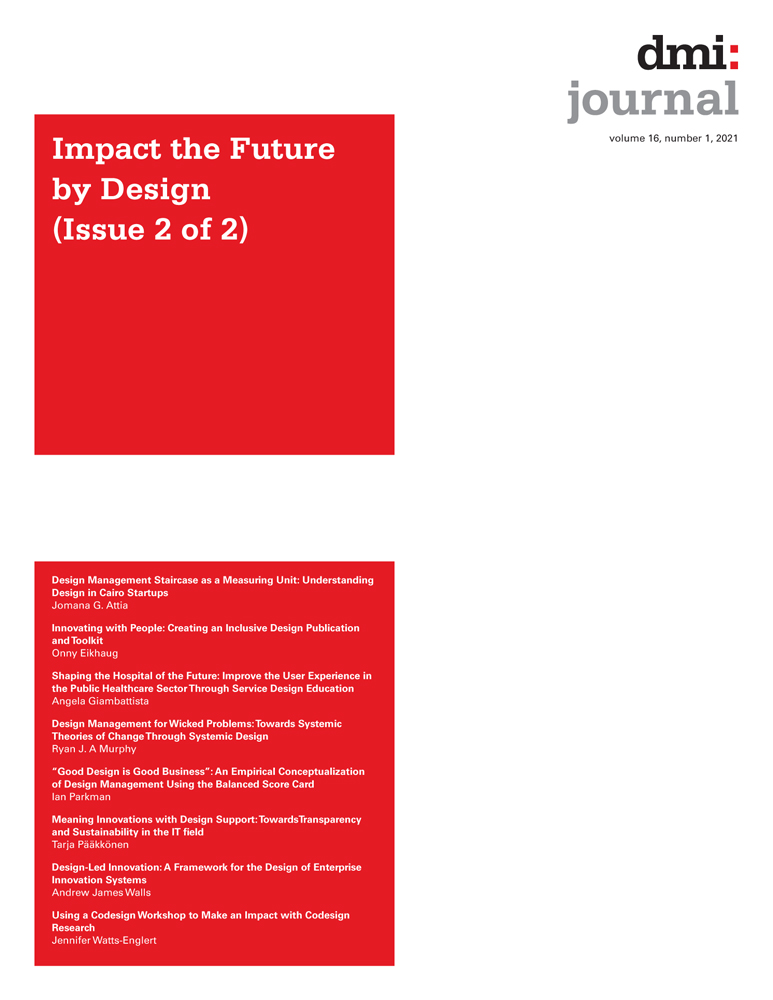Design-Led Innovation: A Framework for the Design of Enterprise Innovation Systems
Abstract
Innovation is not business as usual. Many enterprises struggle to build the systems necessary to consistently deliver new and improved sources of value to customers and stakeholders. Through a thematic analysis, expert interviews, systems mapping, and a case study with the $100B Ontario Municipal Employees Retirement System (OMERS), this paper presents a framework for the design of enterprise innovation systems, called the innovation systems design cycle (ISDC). To apply the ISDC, innovators iteratively plan, build, check, and refine innovation systems. The ISDC framework is detailed with new models exploring innovation system mapping and implementation, modes to assess and compare an innovation system’s development, and configurations to support rapid, adaptable design. Together they support innovators of all experience levels in applying the ISDC to design more resource-efficient innovation systems with a greater capacity to shape an innovation ecosystem and avoid enterprise disruption. The ISDC can be used to build or enhance an innovation system, benchmark performance, frame best practices, quantify value creation potential, demystify innovation systems design, and democratize innovation across not-for-profits and other organizations towards a more just, democratic, and sustainable collective future.
Introduction
Most industries, including media, manufacturing, and retail, are being disrupted by forces such as increased competition, shifting customer expectations, and emerging technologies (Perry, 2017). To avoid declining profits, bankruptcy, or acquisition, many enterprises focus on innovating to deliver new or improved sources of value. Foo (2014) found that 72% of senior executives cite innovation-led growth as a top strategic priority.
Jaruzelski et al. (2018) found effective innovation management led to gross profit growth of 6.6 times industry competitors. Stringer (2000) found many enterprises struggle to innovate effectively. When enterprises fail to manage innovation, they may suffer the fate of acquired or bankrupt enterprises such as Nokia, Blockbuster, Xerox, or Yahoo, who fell behind their competitors’ offerings or customers’ needs and were disrupted. Christensen and Raynor’s (2003) work on disruption indicate enterprises must actively manage innovation.
Managing innovation involves designing a system in which processes, people, strategy, tools, and resources consistently create new or improved sources of stakeholder value (Buchanan, 2019). Innovation systems generally operate by conducting research to evaluate current offerings and identify opportunities, developing identified opportunities into enhancements or new offerings, and supporting the delivery of enhancements or new offerings to the existing enterprise or a new business entity.
Innovation is not business as usual. Van Wulfen (2016) found modern innovation efforts fail 96% of the time. Cierpicki et al. (2000) found seven out of 10 products fail in their first 18 months to two years on the market. The failure seems to stem from how enterprises design innovation systems. Alon et al. (2015) found that 82% of enterprises manage innovation in the same way they manage their typical operations. This goes against Verganti (2009), who found successful innovators, such as Italian design firm Artemide, design systems specifically to create new or improved sources of stakeholder value. Further to this point, Robertson and Breen (2014) found that effective innovation management led to Lego becoming the world’s largest toy company, worth an estimated $15 billion.
Brown’s (2009) design thinking demonstrates that innovation can involve a repeatable, predictable design process. However, no equivalent models exist for designing innovation systems. Some models cover components. Cooper’s (1990) stage gate effectively manages innovation resourcing and process, while Nagji and Tuff’s (2014) ambition matrix effectively manages an innovation portfolio. However, there appears to be a connection between the limited theoretical models and the pervasive failure of modern innovation efforts, causing enterprises to struggle to create new or improved sources of stakeholder value.
Therefore, this research paper will propose a repeatable and predictable framework for the design of enterprise innovation systems.
Literature review
- Ecosystem: The broader system within which an innovation system is embedded.
- Strategy: The current and desired ecosystem position and intended route of an innovation system.
- Architecture: The structural design of an innovation system.
- People: The members of an innovation system.
- Infrastructure: The resources that support an innovation system.
Ecosystem
An innovation ecosystem is the interconnected web of actors, relationships, drivers, regulations, capital, education systems, and talent base outside of an innovation system (Moore, 1993). Ecosystems have membranes that distinguish the innovation system from its surrounding ecosystem (Kohn et al., 2000). Chesbrough et al., (2006) suggest the ecosystem is the place from which innovation inputs – including ideas, feedback, and insights – originate. Sherman and Schultz (1998) found that open innovation systems allow for more complex, effective innovation creation. Huizingh (2011) found a relationship between the openness of an innovation system and innovation effectiveness. Buchanan (2001) suggests that enterprises can design innovation ecosystems, as Lego did with their Lego Ideas platform, enabling Lego enthusiasts to offer ideas that Lego can use as inputs for their innovation process. Lustig (2015) explores how drivers of change, such as automation, change ecosystems over time. Nambisan and Baron (2013) suggest that the most innovative enterprises can reshape or navigate between ecosystems. Chia and Holt (2009) explore the role of wayfinding and emergence in strategic thinking and its role in navigating ecosystems.
Ecosystems are nuanced and complex. Many systems design theorists (Kossiakoff et al., 2011; Segers, 2015) have attempted to develop models to map ecosystems. However, they struggle with visualizing the overwhelming complexity. Nevertheless, there are emerging principles for systemic design (van der Bijl-Brouwer & Malcom, 2020). Some theorists (Beer, 1995; Jaques, 1997; Spewak & Hill, 1992; Taylor, 1911) have attempted to develop models for designing enterprises that seamlessly execute strategies within their ecosystems. They suggest that enterprises that fit their ecosystem are more likely to thrive, much like in the natural world. Normann and Ramirez (1993) explore how value can spread throughout actors in an ecosystem, which they call a value constellation. They suggest the fittest entities spread the most value. Varela et al. (1974) call these value connections structural couplings and suggest enterprises co-evolve in response to interactions with other entities.
Karim and Mitchell (2004) explore possible roles for actors in innovation ecosystems, such as acquisitions, internal product development, and joint ventures. It appears that most enterprise innovators fail to design for the rich, varied components of an innovation ecosystem, which could account for why many innovation systems underperform (Van der Panne et al., 2003). Through analyzing power differentials, relative resource concentrations, agility, and fit in competitive business ecosystems, Hoverstadt and Loh (2017) found that enterprises can use strategy to navigate an ecosystem.
Strategy
Mintzberg (1987) defines strategy as a deliberate plan made ahead of action to achieve a desired objective. Some enterprises choose to define a distinct innovation strategy. For example, Lantmännen, a Nordic agricultural cooperative, planned for “6 percent growth in the core business and 2 percent growth in new organic ventures” (de Jong et al., 2015, p. 4). Other enterprises choose to fit innovation into their enterprise-wide strategy. Bristol-Myers Squibb (BMS) “decided to shift its repertoire of technological capabilities from its traditional organic-chemistry base toward biotechnology” (Pisano, 2015, p. 5). Birshan et al. (2011) found a clear relationship between value creation and corporate strategy, suggesting that strategy is necessary for designing an innovation system.
Amidon (2009) found that while visions do not address obstacles, they can help align enterprises through shared goals – especially when it comes to innovations with high levels of change, such as disruptive or transformational ones, which Ettlie (2007) estimates comprise 6-10% of enterprise innovations. Van der Heijden et al. (2002) found compelling visions can significantly enhance enterprise innovativeness and should be time-bound, inspiring, and able to create a shared purpose among leaders and employees.
Talke et al. (2010) found that enterprises become more innovative by breaking down a vision into innovation fields or focus areas. Phaal et al. (2005) discuss how roadmaps – or timelines and specific activities that, if executed, will theoretically lead to a strategy’s successful execution – can be useful as they “can be more widely disseminated, acting as a reference point for ongoing dialogue and action.” (p. 2)
Lafley and Martin (2013) explore a model known as the choice cascade, which describes how to match capabilities and management systems to an enterprise strategy. They believe that when strategic choices reinforce each other, there are fewer unnecessary costs and a higher chance of a strategy succeeding.
Innovation faces many of the same barriers and risks as other business areas, including demotivating management, financial losses, compliance, inefficient operations, and loss of reputation. Innovation adds many additional risks. For instance, Christensen (1997) explains the innovator’s dilemma: enterprises are disincentivized to pursue innovation in the short term as it produces lower immediate profits and risks cannibalizing existing business lines. Additionally, Blank (2005) explains innovation fatigue: enterprises become cynical and frustrated with innovation from experiencing low rates of successful execution.
Together, a vision, focus areas, capabilities, a roadmap, and barriers or risks present a base for what constitutes an innovation strategy. Overall, a strategy is about navigating to a certain ecosystem position, determined by the enterprise leader’s priorities or by what strategy best fits within the ecosystem.
Architecture
Innovation architecture is the conceptual blueprint for how enterprises identify and transform insights or ideas into new or improved sources of stakeholder value. Verloop and Wissema (2004) describe an insight as a novel view on a customer problem or market need, which supports Sanders and Stappers’ (2013) and Osterwalder and Pigneur's (2010) knowledge-based models of innovation. Sanders and Stappers (2013) describe an idea as a new method or process. Carlson and Wilmot (2006) describe a value proposition as an insight into a market need and an idea to address that need. Adding to this description, Osterwalder et al. (2014) define a value proposition as “the benefits customers can expect from your products or services” (p. 6). Chidamber and Kon (1993) describe technology-push and demand-pull, where innovations originate from profits that lure enterprises to push solutions that create or discover market needs. Chesbrough et al. (2006) suggest that many successful enterprises harness both technology-push and demand-pull to create product-market fits more quickly and reliably, indicating that innovation systems must encompass both insights and ideas.
Enterprises usually prefer to formally define innovation processes to hedge financial risk and build managerial controls (Borgelt & Falk, 2007). The most used innovation process model is what Cooper (1990) termed stage gate, or what McGrath and MacMillan (1995) call discovery-driven planning. Both concepts involve defining gates that innovations must pass through to continue to receive resource support and stages that innovators must follow to reach the next gate. The British Design Council (2005) describes the most common stages: discover, define, develop, and deliver. Brown (2009) refines this approach with design thinking, involving the stages: empathize, define, ideate, prototype, and test. Rather than stages, Ries (2011) describes the build-measure-learn cycle, which is a feedback loop for developing new products. Keeley et al. (2013) define the balanced breakthroughs model, which offers three parallel streams of work – customer, technology, and business – which occur throughout innovation development.
Flynn et al. (2003) define an idea funnel as exploring more insights and ideas than the number of enhancements and new offerings launched. Nagji and Tuff (2014) suggest developing a mixture of enhancements, new offerings, and transformational innovations to manage an idea funnel, known as the ambition matrix. While Baghai et al. (1999) suggest developing a mix of time-to-market innovations in horizon 1 (0-1 year), horizon 2 (1-3 years), and horizon 3 (3+ years) – known as three horizons. They claim that the most profitable, lowest-risk innovation portfolios contain a mixture of all three horizons, with an ideal proportion of 70/20/10 percent across industries.
Metrics can provide objective process or team performance measurements (Kofman, 2018). Kleinknecht et al. (2002) call these metrics innovation indicators in an innovation system. Manuele (2009) groups innovation indicators into two types: leading and lagging. Leading metrics are forward-looking and assess the inputs of innovation, such as innovation velocity. Lagging metrics are retrospective and assess the outputs of innovation, such as hurdle rate. Keeley et al. (2013) suggest aligning metrics with three key risks of innovation: desirability, viability, and feasibility. That being said, metrics can have drawbacks. Knight et al. (2005) claim that assessing team performance by an innovation’s market success leads to innovation empires, where teams become overly invested in the success of their project at the expense of innovation projects elsewhere in the company.
People
Szczepańska-Woszczyna (2014) – supported by Glisson’s (2015) work on culture and innovation – found that three of the four drivers of innovation effectiveness are related to culture and human factors. Needle (2004) defines culture as an enterprise’s vision, values, norms, systems, symbols, language, assumptions, beliefs, and habits. Milne (2007) suggests that while culture is intangible, it is expressed through concrete actions, such as pay rates, hiring practices, norms, and practices. Scotchmer (2004) suggests that while every culture has elements of both intrinsic and extrinsic motivations, intrinsic motivations are more motivating for knowledge work. Ryan and Deci (2000) claim that extrinsic motivations are tied to promotions, raises, and other status indicators. Pink (2011) states that intrinsic motivations fall into mastery, autonomy, and purpose and are more impactful on knowledge work, like innovation.
To create an intrinsic culture, Hogan and Coote (2014) suggest that enterprises must go past surface-level artifacts towards deeper cultural layers, such as behaviours and norms. Kohn (1999) found that most enterprises focus solely on extrinsic motivation by encouraging employees to earn rewards for themselves. Alm et al. (2014) found that cultures that promote effective innovation share five traits: innovation readiness, creativity and learning, leadership and entrepreneurship, market orientation, and motivations and relations. Kesting et al. (2015) found that leadership is a significant determinant of innovation outcomes since leaders create intrinsic motivation by guiding behaviours and norms. Whitford (2006) found that leadership or cultures that punish failure stifle innovation. Johansson and Jönsson (2014) emphasize participatory decision-making’s role in effective value creation.
Miles et al. (1978) found bureaucratic, command-and-control enterprises with formalized job descriptions, low tolerance of deviance from prescribed behaviour, and centralized vertical decision-making are too inflexible and slow to keep pace with a fast-changing world. Thus, agile working practices are common in innovation systems (Balaji & Murugaiyan, 2012). Agile practices guide work through predictable routines and rituals, encouraging team cohesion and doubling innovation velocity (Rigby et al., 2016; Smith & Stewart, 2011).
Many enterprises prefer agile methodology, as it mirrors conventional working practices. Alon et al. (2015) found that 82% of enterprises attempt to innovate the same way they run their typical operations. However, Keegan and Turner (2002) found that conventional management practices stifle innovation, which increases frustration and turnover, lowers overall productivity, and encourages falsified metrics to meet performance objectives – making those metrics unreliable (Hamel, 2006). Doerr’s (2018) objectives and key results (OKR) model offers a more autonomous alternative to agile. Feldman (1989) found autonomy enhances innovation outcomes. Rather than OKRs, frameworks such as the deliberately development organization model (Kegan et al., 2016), teal organization (Laloux, 2014), holacracy (Robertson, 2015), and results-only work environments (Ressler & Thompson, 2008) encourage autonomy through individual responsibility for personal and shared growth and development. Barsh et al. (2008) found that planned innovation education can encourage employees to create and launch new or improved offerings better.
Infrastructure
Infrastructure is the space, digital or analog tools, frameworks, and artifacts that support innovation. Moultrie et al. (2007) found that many enterprises discount the importance of email clients, software subscriptions, meeting rooms, informal spaces, cell phones, computers, and other tools that underly enterprise productivity, including that of an innovation system. Humble et al. (2015) believe that most enterprises select tools to satisfy procurement or finance rather than best support innovation work. Thomke (2006) demonstrates that tools can be a competitive advantage that boosts productivity, avoids time-consuming workarounds, and offers employees more agency in their work, boosting workplace satisfaction. Allen and Henn (2007) found physical space is a significant determinant of innovation, as space can guide collisions, manage information, and empower innovators. Although, Moultrie et al. (2007) found that tools are important but less a determinant of innovation than other factors such as strategy or architecture.
Infrastructure that encourages collaboration, spontaneous collisions, and quiet work can encourage people to feel comfortable and engaged with their work and each other, encouraging superior innovation outcomes.
Methodology
This research paper aims to propose a repeatable and predictable framework for the design of enterprise innovation systems. The purpose of a framework is to support effective decision-making. Therefore, the primary research question for this paper is, “What actions should designers take to design effective innovation systems?”
I chose this paper’s methodology to integrate secondary research, real-world experience, and structured synthesis into a robust, practical framework. Building on my literature review, I have selected four further methods:
Thematic analysis
Through compiling, coding, and grouping 250 innovation approaches – data points that indicate how innovation is managed, such as the business model canvas (Osterwalder & Pigneur, 2010) – I designed a framework for delineating the overarching ways in which innovations are designed.
Expert interviews
Drawing on an interview guide structured around the five innovation indicators defined in the literature review, I conducted 11 interviews with a range of innovation experts and practitioners to layer lived experience and real-world examples into the framework. Table 1 highlights the interview participants.
| # | Role | Domain |
|---|---|---|
| 1 | Innovation Policy Expert | Government |
| 2 | Partner, Theorist | Applied Research, Academia |
| 3 | Partner | Innovation Services |
| 4 | CEO | Innovation Education |
| 5 | Co-Founder | Innovation Services |
| 6 | Founder | Startup |
| 7 | Executive Director | Incubator |
| 8 | Chief Innovation Officer | Primary Industry |
| 9 | Innovation Advisor | Primary Industry |
| 10 | Product Management | Healthcare |
| 11 | Vice President, Innovation | Manufacturing |
Systems mapping
Using Checkland’s (1972) rich picture technique – which involves creating a visual model of a system through identifying, labelling, and drawing connections between different components – I mapped how the different components of an innovation system interact.
Case study
Finally, I conducted a case study with the Ontario Municipal Employees Retirement System (OMERS), which provides a consistent income in retirement to 500,000 Ontarians. OMERS is one of the world’s 100 largest institutional investors (as of 2019), with over $100 billion in assets under management. The case study tested two use cases for designing an innovation system: enhancing an existing innovation system and generating a new innovation system. I conducted this case study by reviewing internal and external documents, observation, and conducting informal interviews with OMERS employees.
Findings
This section describes seven models for understanding and designing innovation systems I developed through the literature review, thematic analysis, expert interviews, systems mapping, and case study, culminating in the Innovation Systems Design Cycle (ISDC) framework.
The innovation design map
Building on the five levers of an innovation system identified in the literature review, I analysed 250 innovation approaches to understand how innovators typically approach innovation and determine the specific sequence designers should follow when designing an innovation system.
Initially, I identified many possible components, including culture, process, structure, management, and stakeholders, which I sorted into five types: ecosystem, strategy, architecture, people, and infrastructure. Table 2 highlights how I organized and tagged the approaches and types:
| Name | Description | Type | Source |
|---|---|---|---|
| Horizon Scanning | A bird’s-eye view of an environment’s landscape and signals of change. | Ecosystem | Aguilar, F. J. (1967). Scanning the business environment. Stuttgart, Germany: Macmillan. |
| Ten Types of Innovation | A periodic table of ten principles of effective innovation. | Strategy | Keeley, L., Walters, H., Pikkel, R., & Quinn, B. (2013). Ten types of innovation: The discipline of building breakthroughs. Hoboken, NJ:Wileyn. |
| Teal Organization | An organizational model characterized by self-management, wholeness, and evolutionary purpose. | Architecture | Laloux, F. (2014). Reinventing organizations: A guide to creating organizations inspired by the next stage in human consciousness. Millias, MA: Nelson Parker. |
| 5 Dysfunctions of a Team | The root causes of politics and team dysfunctions. | People | Lencioni, P. (2006). The five dysfunctions of a team. Hoboken, NJ: Wiley. |
| Service Blueprinting | An operational planning tool for defining how a service will be provided. | Infrastructure | Shostack, G. L. (1982). How to design a service. European Journal of Marketing, 16(1), 49-63. |
From reviewing Sanders’ (2008) design practices map, I created a similar map to visualize how innovators typically approach innovation. The approach is known as constellation mapping and involves mapping individual points to a grid and then finding patterns within the points, similar to finding constellations from stars.
- Focus: The focus axis indicates where an innovation approach is concentrated, from outside to inside an enterprise.
- Thinking: The thinking axis indicates the approach’s relationship to decision-making, from divergent to convergent thinking.
| Name | Volume | Percentage of 250 Approaches |
|---|---|---|
| Ecosystem | 44 | 17.6% |
| Strategy | 45 | 18% |
| Architecture | 49 | 19.6% |
| People | 66 | 26.4% |
| Infrastructure | 46 | 18.4% |
Table 3 indicates the volume of the 250 innovation approaches in each lever from the literature review:
Drawing on the five levers, two axes, and the proportions identified in Table 3, I constructed the innovation design map, seen in Figure 1.
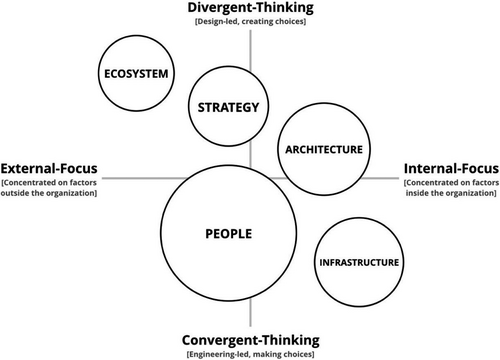
The approaches trickle down from exploring and acting on the possibilities in the ecosystem to identifying and acquiring infrastructure that supports the architecture and people of the enterprise. Despite the non-linear nature of system design, management theorists, such as Hoverstadt and Loh (2017), support having a process for it. From ecosystem to infrastructure, this sequence seems to highlight a possible process a designer should follow when designing an innovation system.
The innovation systems map
With a systems design process uncovered by the innovation design map, I conducted a system mapping activity to uncover interactions in this process. For my approach, I explored several different systems mapping techniques, including synthesis mapping (Jones & Bowes, 2017) and the ERAF system technique (Kumar, 2012), before settling on using Checkland’s (1972) rich picture technique because of its emphasis on visualizing the system. Rich picture involves creating a visual model of a system through identifying, labelling, and drawing connections between different components.
First, I sorted and grouped components identified in the literature review, thematic analysis, and interviews. After several revisions, I created the innovation systems map (Figure 2), which visually models the position and function of the levers and components of an innovation system. For instance, that strategy involves navigating the ecosystem.
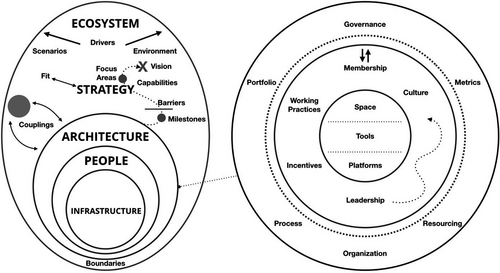
The innovation systems map demonstrates that each lever is embedded in the lever above it, mirroring the embeddedness seen in Beer’s (1995) viable systems model (VSM). VSM is an enterprise systems model that explores the design of enterprises that are adaptive or in front of shifts in their ecosystems, rather than reactive or behind them. Each lever impacts, and is impacted by, all the levers around it. For example, an enterprise’s innovation architecture is shaped by the ecosystem and strategy within which the architecture is structured and shapes which people and infrastructure are most appropriate to navigate that ecosystem.
The innovation cascade
Based on the input of 11 innovation experts, I refined the innovation systems map into a simple visualization for an innovator to use to enhance or build their innovation system. From Cohn’s (2013) process for designing an innovation framework, I reviewed several tools that were like my proposed tool, including the choice cascade (Lafley & Martin, 2013), business model canvas (Osterwalder & Pigneur, 2010), operating system canvas (Dignan, 2019), empathy map (Gray, Brown, & Macanufo, 2010), and mental model diagram (Young, 2008).
I found that designers use tools individually and in groups. Further, tools provide a conceptual framework to structure thinking and are a visual template to map thinking. Following these best practices, I designed the innovation cascade (Figure 3), which I named in reference to Lafley and Martin’s (2013) choice cascade since both frameworks offer a set of five integrated, sequential areas to explore when designing an enterprise system.
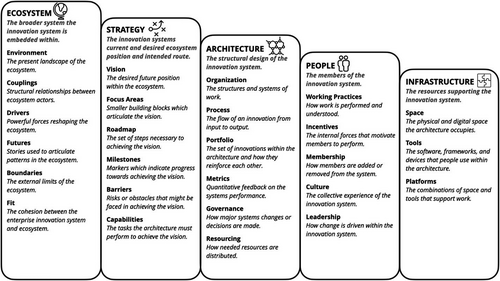
Each column of the innovation cascade represents one of five innovation systems levers in the order of ecosystem, strategy, architecture, people, and infrastructure. Each lever contains several components, which are more granular areas for a designer to explore within each lever.
The visual presents a linear, sequential process for designing an innovation system, which is not reflective of reality. Design is messy. It involves cycling back and forth between levers, implementing different components, and iterating repeatedly. However, other systems design models, such as Beer’s (1995) VSM, present an overwhelming complexity that seems to challenge newcomers and experienced practitioners. The innovation cascade simplifies that complexity by presenting it to designers as a defined set of levers and components, each of which can be designed and implemented in the sequence presented.
Using the innovation cascade
To enhance the usability of the innovation cascade model, I designed a five-step process for using the innovation cascade (Figure 4). I based this process on a review of existing change management and innovation design processes, including the 8-step change model (Kotter, 1995), logical incrementalism (Lindblom, 1959), the iterative process of inquiry (Gharajedaghi, 2011), the innovation wheel (Basadur, 1995), and the design innovation process (Kumar, 2012).
The five steps are search, map, shape, make, and drive. Each step corresponds to one of the five levers. To support designers in applying the steps, I matched each step with possible design approaches. Two loops appear within the five steps. First, innovators iterate between searching and mapping until a strategy emerges that brings the innovator to their desired objective within their innovation ecosystem. Second, innovators iterate among architecture, people, and infrastructure to build the internal conditions in which innovation system members can successfully execute the strategy. Mirroring Mazzucato’s (2002) strategy development loop, the five steps form a figure eight, where innovators cycle through external and internal design work.
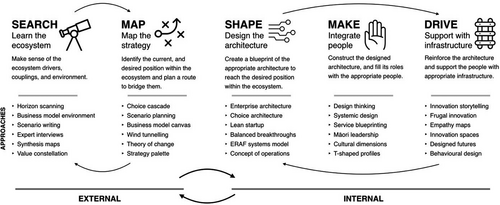
- Enhancing: Identifying, understanding, and mapping the existing components of an innovation system to frame and implement improvements.
- Generating: Framing, designing, and building a new innovation system.
Case study on the innovation cascade
The value of the innovation cascade lies in surfacing areas of inquiry and providing a skeleton for making sense of them. Buehring and Bishop’s (2020) case study on strategic foresight and design in financial services supports the value of this approach. To test the innovation cascade, I applied it to both use cases through a case study with the Ontario Municipal Employees Retirement System (OMERS). The case study was conducted in coordination with innovation leadership by reviewing internal documents, observing practices and norms, and conducting informal interviews with employees and leaders: figures 5 and 6 highlight my findings. Figure 5 uses the Innovation Cascade visual to map the existing innovation system, while figure 6 uses OMERS design language (OMERS, 2020) to generate a new research function at the front-end of the broader innovation system. Both figures reflect my synthesis of the OMERS innovation system (as of December 2019).
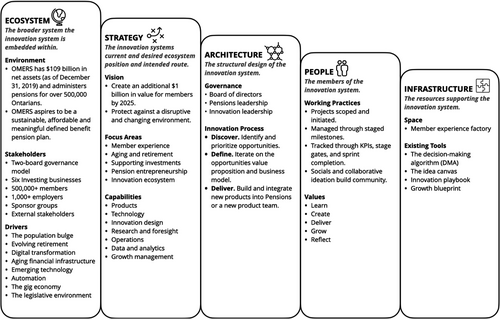
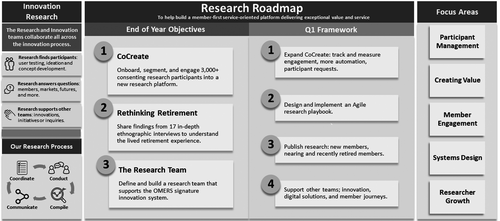
The five innovation system modes
After exploring secondary cases (namely, by applying the innovation cascade to enterprises like Whirlpool, the Bill and Melinda Gates Foundation, Lego, and General Electric), I identified consistent forms that innovations systems take, which I call modes. The five modes are informal, linear, distributed, embedded, and emergent (Figure 7).

The modes offer a vocabulary and structure to discuss and compare innovation systems while providing a model for diagnosing different enterprise’s innovation needs and realities. These modes are not linear stages that an innovation system moves through sequentially. Instead, they build on other innovation framework models (Eleveens, 2010; Grassl et al., 2017; O’ Raghallaigh et al., 2011; Rothwell, 1994; Steelcase, 2017) to indicate the general trajectory an innovation system takes as it evolves. They capture the various forms that innovation systems can take, given the many organizational, environmental, strategic, and human factors at play and simplify it into archetypes that indicate the system’s likely capacity to influence an ecosystem through innovation.
Each mode comes with trade-offs, such as resource costs, complexity, and the scale of innovation outputs. Different enterprises prefer different levels of control, influence, openness, and strategy alignment (Dougherty & Hardy, 1996; Keum & See, 2017). However, based on Viguerie et al. (2016) finding of an increased rate of organizational disruption, it is apparent most enterprises would prefer to have a distributed, embedded, or emergent innovation system to ensure their rate of innovation keeps pace with change in their ecosystem (Kock & Georg Gemünden, 2016) to avoid disruption (Lefebvre, 2013), as enterprises like Nokia, Blockbuster, Xerox, or Yahoo have faced.
Godin (2014) found that most innovation systems seem to predominately be in informal or linear modes, suggesting enterprises may find the modes valuable as a path forward for diagnosing and enhancing their innovation systems to avoid disruption and capture opportunity.
Configuring innovation systems
The modes help to provide language for diagnosing innovation systems but do not address diagnosed issues. One solution to addressing diagnosed issues is configuration. Van der Aalst et al. (2010) describe a configuration as a set of possible forms a component of a process can take.
From adapting Hoverstadt and Loh’s (2017) strategy development model, I designed three configurations for each lever that offer the means of rapidly constructing a ready-made innovation system across all five (Figure 8).
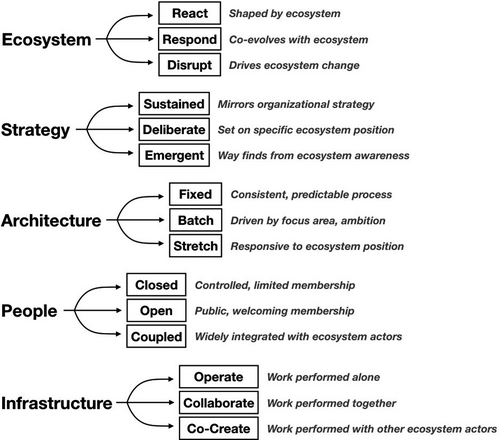
For innovation systems, configuration support rapid, predictable solutions to consistent innovation problems, such as innovation fatigue (Blank, 2005), by reducing decision complexity by offering a manageable range of potential choices. Configurations can help bring consistency and comparability across innovation systems, permitting experienced designers to rapidly enhance or design innovation systems and support new designers with learning best practices and the range of choices available to them.
The innovation systems design cycle
Together, the innovation cascade, steps, modes, and configurations form a robust framework for designing, enhancing, understanding, and communicating innovation systems. These models integrate to form a cycle I call the innovation systems design cycle (ISDC), which mirrors decision-action processes, such as the PDCA cycle (Moen, 2010), OODA loop (Angerman, 2004), and build-measure-learn cycle (Ries, 2011).
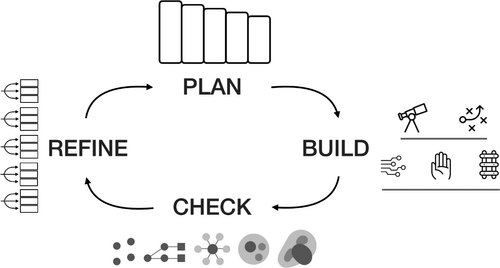
- Plan: Scope a detailed blueprint for enhancing or generating an innovation system.
- Build: Design the external and internal conditions to implement the blueprint.
- Check: Measure performance relative to industry benchmarks to gauge progress and frame future iterations.
- Refine: Draw on best practices or configurations and iterate accordingly.
Like Gharajedaghi’s (2011) iterative process of inquiry, the ISDC involves repeated narrowing cycles through the four nodes, with each cycle creating a more resource-efficient innovation system with a greater capacity to shape its ecosystem.
Implications
This research paper aimed to propose a repeatable and predictable framework for the design of enterprise innovation systems. Through a literature review, thematic analysis, expert interviews, systems mapping, and case study, this paper detailed the Innovation Systems Design Cycle (ISDC) framework, which permits an innovator of any skill level to understand and design an enterprise innovation system.
The ISDC can be used to build an innovation system from scratch, for diagnosis and redesign, or ongoing maintenance. Furthermore, the ISDC could permit the comparison of innovation systems through benchmarking performance across many enterprise samples to frame best practices for innovation systems design and allow an enterprise to quantify the value creation potential of an innovation system before and during its construction.
Long-term implications include more informed decision-making for leaders with innovation agendas, demystifying enterprise innovation, and welcoming non-practitioner stakeholders into innovation beyond simple ideating activities or workshops.
Further, as we collectively confront global challenges such as climate change, resource overconsumption, and health crises, innovation is more necessary than ever before – not only for innovating products or services but also innovating institutions, political ideologies, and economic systems. We must free innovation of the dogma, mystification, and esoteric theories that limit it to a select few to democratize innovation. Ultimately, so not-for-profits, social enterprises, startups, public service agencies, and any other organization can equally offer their stakeholders value.
Through the case study with OMERS, the ISDC demonstrated that it provides a common language for innovation dialogue, simplifies systems design through a blueprint to map scattered information, and supports integrated conversations about innovation across different focuses and backgrounds. For leaders in research, design, and innovation across entities of all types, the ISDC is a necessary next step forward but only a small step of the journey towards a more just, democratic, and sustainable collective future.
Acknowledgements
Thank you to my family, friends, and colleagues for your kindness, attention to detail, and support. This research would not have been possible without you, and I am endlessly grateful.
Biography

Andrew James Walls is a designer, strategist, futurist, and social entrepreneur from Toronto, Canada. He has a Master of Design from OCAD University and a Bachelor of Commerce from Ryerson University. He is a founding member of OMERS Innovation at the $100B+ DB pension fund OMERS. Andrew specializes in disruptive innovation in healthcare, finance, the built environment, sustainability, and community empowerment.



